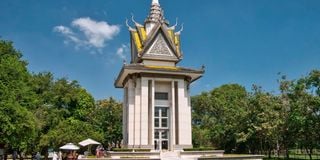Premium
In the killing fields of Cambodia

Buddhist memorial stupa at Choeung Ek killing fields, Cambodia.
From a Going Places perspective, it was one of my most fascinating assignments. I was a member of a consultancy team carrying out a review of the management structures and management processes of the Mekong River Commission.
It involved fieldwork in four South-East Asian countries: Laos, where the Commission has its headquarters in Vientiane, Cambodia, Thailand and Vietnam.
But the focus of this article is on Cambodia, a country that had experienced one of the most brutal regimes of modern times – the regime of the Khmer Rouge that ruled the country from 1975 to 1979.
Our Mekong River Commission consultancy was carried out in the closing months of 2006. Even then, the atmosphere was still febrile and unsettled. On our very first morning, as we made for the carpark of our hotel in the capitol, Phnom Penh – a hotel rather like the Fairview here in Nairobi – a black SUV drove into the slot next to our hire car.
A young man in a slick suit got out, opened a back door and took out an AK47, which he locked in the car’s boot. He did it conscious that he was being watched, and he did it as casually as if he was handling his bag of golf clubs or his morning’s shopping.
However, it was not until I was taking a time out and I visited the S-21 Security Prison in the capital that I began to be confronted by the full horrors of the Khmer Rouge persecutions. It had been a secondary school. It became the regime’s main interrogation and torture centre.
The Khmer Rouge were operating according to an extreme and twisted version of communism, creating a wholly agrarian socialist state and eradicating anyone with ‘capitalist tendencies’ – business people, professionals, intellectuals.
Most of those taken to S-21 were condemned and sent out to be killed – killed in horrific ways. To save on ammunition, the killers – little more than boys – used clubs and sharpened bamboo stakes. The heads of young children were smashed against the trunks of trees.
I went on to visit Choeung Ek, the main killing field, only 10 kilometres from the city centre. There was a tower of skulls, housed within an elegant Buddhist stupa. Many of those skulls must have been of the people whose photographs I had just seen at S-21.
The ground around the stupa was uneven – evidence of many shallow graves. I was told, in times of heavy rain, bones and bits of clothing would be exposed.
I realised that the Cambodian consultant who had taken me to Choeung Ek must have lived through the time of the Khmer Rouge. I asked him how he had survived. ‘I melted back into village life,’ he said. ‘But you had to be very careful.
For example, if the Khmer Rouge people came and asked you to read a text they showed you, even if you said you couldn’t, if your eyes had made a movement along a line of text, that was a confirmation that you were lying.
Also, peasants don’t wear sandals, so you would remove them when you knew the Khmer Rouge were on their way. But if they could see where the straps had fitted across your feet, then you would be arrested. You had to be very, very careful.’
The following day, the team leader and I went for lunch at the Foreign Correspondents Club in Phnom Penh. The top-floor restaurant has a magnificent view of the great Mekong River. My colleague laughed at me when I ordered Sausage and Mash. ‘How can you do that?’ he asked. ‘Here you are in exotic South-East Asia, and you order Sausage and Mash.’
I didn’t tell him, but I reckoned, after the events of the previous day, I felt in need of something ordinary and familiar.
John Fox is Chairman of iDC Email: [email protected]





